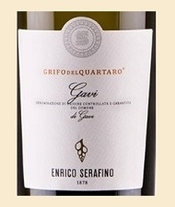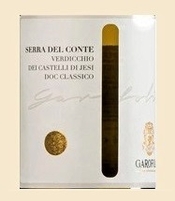Enrico Serafino (Piedmont) Gavi DOCG “Grifo del Quartaro” 2020 ($17) and
Garofoli (Marche) Verdicchio Castelli di Jesi Classico DOC 2020 ($12) (both Dalla Terra Winery Direct):
Exploring Italy’s indigenous grape varieties is an ideal pathway to expanding your knowledge of Italian wines. Many native varieties flourish in only one or two Italian regions, and produce wines with a regional signature as well as that of the variety.
I recently received a sample pack of six white Italian wines that are the product of 6 grape varieties from five different regions. Discussing them all would be too ambitious for this column. But two of the wines are wines that I know well from purchasing them for my classes on Italian wine. Both wines are white and unoaked, but they are markedly different in style — as well as being high quality and eminently affordable.

The first is a Gavi di Gavi DOCG. Gavi is a wine zone in Piedmont, in northwestern Italy. Although the huge majority of Piedmontese wines are red, Gavi is white, made from the Cortese variety. Cortese produces wines with high acidity and fairly light aromas. The origins of the Gavi zone track back to Cortese’s potential for sparkling wine — for which high acidity and neutral aromas and flavors can be desirable. Today, Gavi is a dry, medium-bodied, crisp white with lemony flavors and savory mineral notes. Large grape crops strip any character from Cortese, and the best wines are therefore those from serious producers and from the best sites in the zone.
Fans of serious Piedmontese red wines are familiar with the Langhe area around the town of Alba in southeastern Piedmont. Gavi is situated farther east, in the province of Alessandria, close to the coastal region of Liguria. I bet that many wine aficionados who visit Piedmont never venture toward Gavi, and that’s understandable: far too many wines to explore in the Langhe. But Gavi is an historic Italian white wine that 50 or 60 years ago was the most famous white wine of Italy.
Enrico Serafino is mainly a Langhe-area producer, but the winery owns a wide array of Piedmontese vineyards. His Gavi is from vineyards in the town of Gavi, thus it is a Gavi di Gavi. The wine is dry and crisp, medium bodied as expected, with aromas of lemon, grapefruit, tart apple, and vaguely a white blossom note — all these aromas expressing themselves quietly. The texture is surprisingly substantial, no doubt due to extended lees contact up to 8 months, which contributes creaminess. When the wine is freshly poured, you can see some visible, still bubbles in the wine; in your mouth, these contribute to the crispness and freshness impression. The wine’s flavors, delicate as they are, persist all through the length of your mouth and end in a dry, minerally long finish. The 2020 Enrico Serafino “Grifo del Quartaro” Gavi di Gavi DOCG ($17) is a good wine and a real Gavi, more approachable and less austere than some of the pricier brands.

My second recommendation is Garofoli Verdiccio from the DOC Castelli di Jesi Classico area of the coastal Marche region in east central Italy. This particular selection is called “Serra del Conte.” It is the most basic Verdicchio that Garofoli makes, and it sells for only $12. It’s meant for early consumption. (Try the “Macrina” of Garofoli, about $17, if you want a more durable style. That is the wine I use in my classes.)
I am a big fan of the Verdicchio grape and of this producer. In my current favorite Italian wine book,
Native Wine Grapes of Italy (Univ. of California Press), Ian d’Agata writes that “Verdicchio is arguably Italy’s greatest native white variety.” We followers of Italian wine are discovering that this variety exists under different names — for example, Trebbiano di Soave — in three or four Italian regions, but Marche is its stronghold. It’s not easy to describe why I love Verdicchio. For one thing, it has richness from truly ripe fruit, but at the same time has terrific acidity that supports the richness. It’s round and creamy, and yet that acidity never lets it fall flat in your mouth.
In terms of aromas and flavors, this Garofoli Verdicchio, the 2020 “Serra del Conte,” has the intensity that Gavi naturally lacks. Lemon, lime, orange peel, and ripe apple are evident in the aroma and flavor of this wine, along with a saline character that recalls the sea. It’s dry but fruity, its body is on the rich end of medium, its acidity is persistent, and its texture is what you might call oily. A well-balanced wine, flavorful and easy to enjoy, with the unique imprint of the Verdicchio grape.
I like both of these wines when they are cold, not cool. The Verdicchio can manage a more substantial dish than the Gavi — grilled salmon rather than a delicate seafood pasta — but I’d also enjoy them alone as an aperitif.
2020 Enrico Serafino “Grifo del Quartaro” Gavi di Gavi DOCG,
91 Points
2020 Garofoli “Serra del Conte” Verdicchio Castelli di Jesi Classico DOC,
90 Points